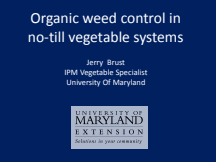Updated: November 5, 2024
A Guide for Identifying Pigweed Species Commonly Found in Maryland (EB-2023-0654)
This hand-held guide provides information on how to identify and differentiate common pigweed species in Maryland including: Palmer amaranth, Spiny amaranth, waterhemp, and redroot/smooth pigweed. Authors: Kurt Vollmer and Ben Beale; Title: A Guide for Identifying Pigweed Species Commonly Found in Maryland (EB-2023-0654)
Updated: November 5, 2024
Understanding Glyphosate and Other Pesticides (FS-1193)
Recent concerns about the widespread use of glyphosate and its potential impacts have propelled this herbicide into the national spotlight. This article provides an overview of the regulatory processes glyphosate and other pesticides must undergo to ensure they do not pose unreasonable risks to human health or the environment. Author: Kurt Vollmer; Title: Understanding Glyphosate and Other Pesticides (FS-1193)
Updated: November 5, 2024
Managing Herbicide Resistant Common Ragweed (FS-474)
Common Ragweed (Ambrosia artemisiifolia) is a native summer annual weed of many cropping systems in the mid-Atlantic. It is often encountered as weed in agronomic crops as well as vegetable, orchards, roadsides, and abandoned fields. Common ragweed can thrive in lower fertility soils and is often more severe in reduced or no-tillage situations. In Maryland, populations of glyphosate resistant common ragweed were first confirmed in 2014. Resistance to ALS herbicides was also confirmed the same year. In most areas of Maryland, common ragweed has two-way resistance to both glyphosate and ALS chemistry. In 2017, pockets of three way resistant common ragweed plants were confirmed in parts of Delaware and the Eastern Shore of Maryland to PPO, ALS and glyphosate. Herbicide resistant common ragweed can be very difficult to control in agronomic crops, particularly soybeans. Authors: Benjamin Beale, and Matthew Morris; Title: Managing Herbicide Resistant Common Ragweed (FS-474)



